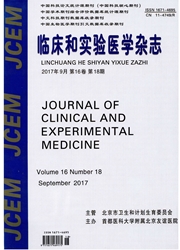

 中文摘要:
中文摘要:
目的 回顾性分析天津医院2011-2015年输尿管结石微创术后残留结石患者的临床特点及影响因素。方法 收集天津医院2011-2015年304例输尿管结石微创手术患者的临床资料,进行统一回顾性分析,所选患者均行输尿管钬激光碎石术,术后行B超、肾-输尿管-膀胱摄影(KUB)检查,根据是否残留结石分为残留组及无残留组,单因素分析两组性别、年龄、体重、麻醉方式、结石数量、结石分布等基线资料差异以观察术后残留结石患者的临床特点,并将术后残留结石作为因变量,设定相关影响因素为自变量,进行Logistic回归性分析,研究术后残留结石的危险因素。结果 304例患者术后共31例出现残留结石,残留率10.2%(31/304),成功率89.8%(273/304);单因素分析显示两组结石位置、合并输尿管狭窄及扭曲、结石移位患者的例数分布存在显著差异(P〈0.05),而性别、年龄、体重、麻醉方式、结石数量、结石分布、结石大小、术前处理、肾积水、合并息肉或包膜对术后结石残留无显著差异(P〉0.05);结石位置回归系数取值为负值,表示结石位置与术后结石残留负相关;输尿管下段结石清除率最高,中段结石为次,上段结石最低。合并输尿管狭窄、扭曲以及结石移位与术后结石残留呈正相关,结合OR值分析,合并输尿管狭窄、扭曲,并有结石移位的患者术后结石残留率高,结石移位对术后结石残留影响最大,后为合并输尿管狭窄、扭曲,结石位置是术后结石残留的保护因素。结论 结石移位、合并输尿管狭窄及扭曲是输尿管结石微创术治疗后结石残留的危险因素,结石位置是术后结石残留的保护因素,下段结石的清除率最高,临床治疗需避免结石移位发生,对合并输尿管狭窄及扭曲患者及时采取中转体外碎石等微创手术干预,降低开放手术率。
 英文摘要:
英文摘要:
Objective Clinical features and influencing factors of residual ureteral calculi after minimally invasive surgeries for patients with ureteral calculi from Tianjin hospital during 2011 to 2015 were retrospectively analyzed. Methods Clinical data of 304 patients with ureteral calculi after minimally invasive surgeries was collected in our hospital from 2011 to 2015 , and were retrospectively reviewed. All of the patients underwent ureteroscopic Holmium laser lithotripsy, B ultrasonic examination and Kidney - Ureter - Bladder ( KUB) examination. All these examinations were conducted after the operation. They were divided into two groups (with residual stones and without residual stones). The gender, age, weight, type of anesthesia, number of stones, distribution of stones, etc. were compared using univariate analysis to assess patients'clinical features. Then postoperative residual stone as the dependent variable, and correlated influencing factors as the independent variables to evaluate the risk factors by using Logistic regression analysis. Results Among the 304 patients, a total of 31 cases (10.2% , 31/304) had residual stones, 273 had no residual stones (89.8% , 273/304). Stone location, ureter straitness and contortion, and stone translocation had no significant difference between the two groups ( P 〈 0 .0 5 ) , while gender, age, weight, type of anesthesia, number of stones, distribution of stones, size of stones, preoperative treatment, hydronephrosis, and ureteral calculi accompanied with polysps or subcapsular had no effect on residual stones after the operation (P 〈0.05). Stone location was negatively correlated with postoperativve stones. The clearance rate of stones in the distal ureter was the highest, then in the mid ureter and clearance rate of stones in the upper ureter was the lowest. Ureter straitness and contortion, and stone translocation were positively correlated with residual stones after the surgery. According to the OR analysis, urete
 同期刊论文项目
同期刊论文项目
 同项目期刊论文
同项目期刊论文
 期刊信息
期刊信息
